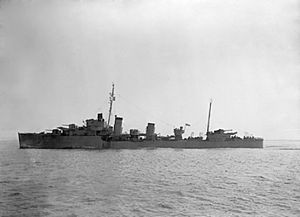Convoy SC 130 facts for kids
Quick facts for kids Convoy SC 130 |
|||||||
|---|---|---|---|---|---|---|---|
| Part of World War II | |||||||
 HMS Duncan in March 1943 |
|||||||
|
|||||||
| Belligerents | |||||||
| Commanders and leaders | |||||||
| Admiral Karl Dönitz | Comm: HC Forsyth B-7 Group: Cdr. P Gretton |
||||||
| Strength | |||||||
| 25 U-boats | 37 ships 8 escorts |
||||||
| Casualties and losses | |||||||
| 3 U-boats destroyed 1 U-boat damaged 142 dead |
no ships sunk | ||||||
Convoy SC 130 was a group of merchant ships. They traveled together across the North Atlantic Ocean. This journey happened during the Battle of the Atlantic in World War II. It was the 130th "Slow Convoy" (SC) from Sydney, Canada, to Liverpool, England. Convoy SC 130 was a very important battle in May 1943. This month was known as "Black May" because of intense fighting.
Contents
Why Convoys Were Important
Convoy SC 130 had thirty-seven merchant ships. They left Halifax, Canada, on May 11, 1943. These ships carried important supplies for the war effort. They were protected by a group of warships called the Western Local Escort Force. This group included the Canadian destroyer Niagara.
Meeting the Mid-Ocean Escort
On May 15, another group of warships joined them. This was the Mid-Ocean Escort Force Group B-7. Commander Peter Gretton led this group on the destroyer HMS Duncan. The escort group also had other ships. These included the destroyer HMS Vidette, the frigate HMS Tay, and several corvettes. Corvettes like HMS Snowflake were smaller warships. They were good at hunting submarines.
Special Support Ships
The convoy also had two special ships called oilers. These ships could refuel and re-arm the escort ships in the middle of the ocean. There was also a rescue ship, Zamalek. This ship was ready to help sailors if their ships were attacked.
The German U-boat Threat
Germany's U-boat Command (BdU) organized 25 U-boats to attack the convoy. These U-boats were arranged in three patrol lines. German intelligence, called B-Dienst, helped them. They knew about several convoys, including SC 130. The British Admiralty also used their own intelligence. They used HF/DF (radio direction finding) and Enigma codebreaking. This helped them know where the U-boats were. This allowed them to send more warships to protect SC 130.
The Battle Begins
On the evening of May 18, 1943, the U-boat U-304 found Convoy SC 130. It started following the convoy. Other U-boats gathered during the night. The B-7 escort group acted very aggressively. They chased down any U-boat they detected. This stopped the U-boats from launching any attacks that night.
Air Support Arrives
On May 19, long-range aircraft joined the battle. A Hudson plane from 269 Squadron destroyed U-273. A Liberator plane from 120 Squadron attacked another U-boat. It was first thought to have sunk U-954. Later, it was believed to have hit U-731, causing only minor damage.
More Escorts and U-boat Sinkings
Later that day, more warships joined the convoy. This was the 1st Support Group. It included the sloop HMS Sennen and three frigates. Within hours, Sennen and Jed sank U-954. They used a special weapon called a Hedgehog. This weapon fired small bombs that exploded on contact. Admiral Karl Dönitz's son, Peter Dönitz, was among those lost on U-954.
Another attack by Snowflake and Duncan hit a U-boat. It was thought to be U-381. But it was later believed to be U-636, which survived with damage. That evening, Tay attacked U-952. It damaged the U-boat so badly that it had to leave the battle.
Final Attacks and Victory
On May 20, the U-boat attacks continued. But they were still unsuccessful. A B-24 Liberator plane from 120 Squadron sank U-258. At midday on May 20, the German U-boat Command called off the attack. The U-boats withdrew. The convoy reached Liverpool safely on May 26.
What Happened Next
Convoy SC 130 was a big victory for the Allies. No merchant ships were lost during the journey. All 35 ships that completed the crossing arrived safely. On the other hand, at least three German U-boats were destroyed. One more U-boat was badly damaged.
This battle was a major setback for the German U-boat fleet. It helped convince the German command to stop their main attacks on North Atlantic convoys. This was a very important turning point in the Battle of the Atlantic.
U-boats Destroyed
| Date | Number | Type | Location | Casualties | Sunk by... |
|---|---|---|---|---|---|
| 19 May 1943 | U-273 | VIIC | N Atlantic 59°25′N 24°33′W / 59.417°N 24.550°W |
46 | Air attack, Hudson M, 269 Sqdn |
| 19 May 1943 | U-954 | VIIC | N Atlantic | 47 | Hedgehogged by Sennen, Jed |
| 20 May 1943 | U-258 | VIIC | N Atlantic 55°18′N 27°49′W / 55.300°N 27.817°W |
49 | Air attack by Liberator F, 120 Sqdn |

